warning lights Seat Ibiza SC 2009 Owner's manual
[x] Cancel search | Manufacturer: SEAT, Model Year: 2009, Model line: Ibiza SC, Model: Seat Ibiza SC 2009Pages: 257, PDF Size: 6.61 MB
Page 5 of 257
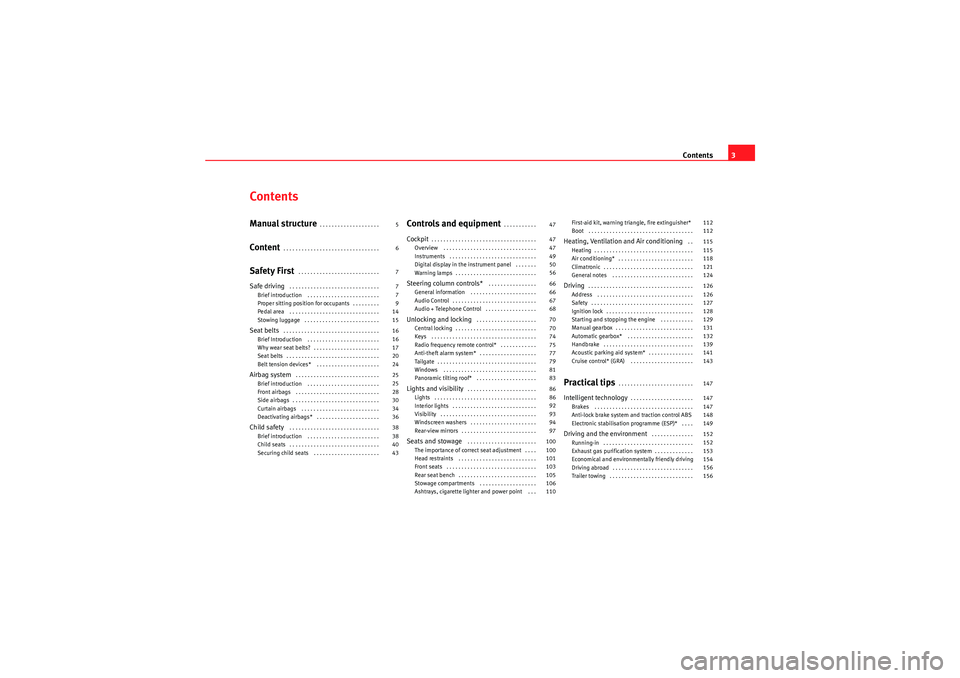
Contents3
ContentsManual structure
. . . . . . . . . . . . . . . . . . . .
Content
. . . . . . . . . . . . . . . . . . . . . . . . . . . . . . . .
Safety First
. . . . . . . . . . . . . . . . . . . . . . . . . . .
Safe driving
. . . . . . . . . . . . . . . . . . . . . . . . . . . . . .
Brief introduction . . . . . . . . . . . . . . . . . . . . . . . .
Proper sitting position for occupants . . . . . . . . .
Pedal area . . . . . . . . . . . . . . . . . . . . . . . . . . . . . .
Stowing luggage . . . . . . . . . . . . . . . . . . . . . . . . .
Seat belts
. . . . . . . . . . . . . . . . . . . . . . . . . . . . . . . .
Brief Introduction . . . . . . . . . . . . . . . . . . . . . . . .
Why wear seat belts? . . . . . . . . . . . . . . . . . . . . . .
Seat belts . . . . . . . . . . . . . . . . . . . . . . . . . . . . . . .
Belt tension devices* . . . . . . . . . . . . . . . . . . . . .
Airbag system
. . . . . . . . . . . . . . . . . . . . . . . . . . . .
Brief introduction . . . . . . . . . . . . . . . . . . . . . . . .
Front airbags . . . . . . . . . . . . . . . . . . . . . . . . . . . .
Side airbags . . . . . . . . . . . . . . . . . . . . . . . . . . . . .
Curtain airbags . . . . . . . . . . . . . . . . . . . . . . . . . .
Deactivating airbags* . . . . . . . . . . . . . . . . . . . . .
Child safety
. . . . . . . . . . . . . . . . . . . . . . . . . . . . . .
Brief introduction . . . . . . . . . . . . . . . . . . . . . . . .
Child seats . . . . . . . . . . . . . . . . . . . . . . . . . . . . . .
Securing child seats . . . . . . . . . . . . . . . . . . . . . .
Controls and equipment
. . . . . . . . . . .
Cockpit
. . . . . . . . . . . . . . . . . . . . . . . . . . . . . . . . . . .
Overview . . . . . . . . . . . . . . . . . . . . . . . . . . . . . . .
Instruments . . . . . . . . . . . . . . . . . . . . . . . . . . . . .
Digital display in the instrument panel . . . . . . .
Warning lamps . . . . . . . . . . . . . . . . . . . . . . . . . . .
Steering column controls*
. . . . . . . . . . . . . . . .
General information . . . . . . . . . . . . . . . . . . . . . .
Audio Control . . . . . . . . . . . . . . . . . . . . . . . . . . . .
Audio + Telephone Control . . . . . . . . . . . . . . . . .
Unlocking and locking
. . . . . . . . . . . . . . . . . . . .
Central locking . . . . . . . . . . . . . . . . . . . . . . . . . . .
Keys . . . . . . . . . . . . . . . . . . . . . . . . . . . . . . . . . . .
Radio frequency remote control* . . . . . . . . . . . .
Anti-theft alarm system* . . . . . . . . . . . . . . . . . . .
Tailgate . . . . . . . . . . . . . . . . . . . . . . . . . . . . . . . . .
Windows . . . . . . . . . . . . . . . . . . . . . . . . . . . . . . .
Panoramic tilting roof* . . . . . . . . . . . . . . . . . . . .
Lights and visibility
. . . . . . . . . . . . . . . . . . . . . . .
Lights . . . . . . . . . . . . . . . . . . . . . . . . . . . . . . . . . .
Interior lights . . . . . . . . . . . . . . . . . . . . . . . . . . . .
Visibility . . . . . . . . . . . . . . . . . . . . . . . . . . . . . . . .
Windscreen washers . . . . . . . . . . . . . . . . . . . . . .
Rear-view mirrors . . . . . . . . . . . . . . . . . . . . . . . . .
Seats and stowage
. . . . . . . . . . . . . . . . . . . . . . .
The importance of correct seat adjustment . . . .
Head restraints . . . . . . . . . . . . . . . . . . . . . . . . . .
Front seats . . . . . . . . . . . . . . . . . . . . . . . . . . . . . .
Rear seat bench . . . . . . . . . . . . . . . . . . . . . . . . . .
Stowage compartments . . . . . . . . . . . . . . . . . . .
Ashtrays, cigarette lighter and power point . . . First-aid kit, warning triangle, fire extinguisher*
Boot . . . . . . . . . . . . . . . . . . . . . . . . . . . . . . . . . . .
Heating, Ventilation and Air conditioning
. .
Heating . . . . . . . . . . . . . . . . . . . . . . . . . . . . . . . . .
Air conditioning* . . . . . . . . . . . . . . . . . . . . . . . . .
Climatronic . . . . . . . . . . . . . . . . . . . . . . . . . . . . . .
General notes . . . . . . . . . . . . . . . . . . . . . . . . . . .
Driving
. . . . . . . . . . . . . . . . . . . . . . . . . . . . . . . . . . .
Address . . . . . . . . . . . . . . . . . . . . . . . . . . . . . . . .
Safety . . . . . . . . . . . . . . . . . . . . . . . . . . . . . . . . . .
Ignition lock . . . . . . . . . . . . . . . . . . . . . . . . . . . . .
Starting and stopping the engine . . . . . . . . . . .
Manual gearbox . . . . . . . . . . . . . . . . . . . . . . . . . .
Automatic gearbox* . . . . . . . . . . . . . . . . . . . . . .
Handbrake . . . . . . . . . . . . . . . . . . . . . . . . . . . . . .
Acoustic parking aid system* . . . . . . . . . . . . . . .
Cruise control* (GRA) . . . . . . . . . . . . . . . . . . . . .
Practical tips
. . . . . . . . . . . . . . . . . . . . . . . . .
Intelligent technology
. . . . . . . . . . . . . . . . . . . . .
Brakes . . . . . . . . . . . . . . . . . . . . . . . . . . . . . . . . .
Anti-lock brake system and traction control ABS
Electronic stabilisation programme (ESP)* . . . .
Driving and the environment
. . . . . . . . . . . . . .
Running-in . . . . . . . . . . . . . . . . . . . . . . . . . . . . . .
Exhaust gas purification system . . . . . . . . . . . . .
Economical and environmentally friendly driving
Driving abroad . . . . . . . . . . . . . . . . . . . . . . . . . . .
Trailer towing . . . . . . . . . . . . . . . . . . . . . . . . . . . .
5
6
7
7
7
9
14
15
16
16
17
20
24
25
25
28
30
34
36
38
38
40
43 47
47
47
49
50
56
66
66
67
68
70
70
74
75
77
79
81
83
86
86
92
93
94
97
100
100
101
103
105
106
110 112
112
115
115
118
121
124
126
126
127
128
129
131
132
139
141
143
147
147
147
148
149
152
152
153
154
156
156
IbizaSC_EN.book Seite 3 Mittwoch, 16. September 2009 12:11 12
Page 10 of 257
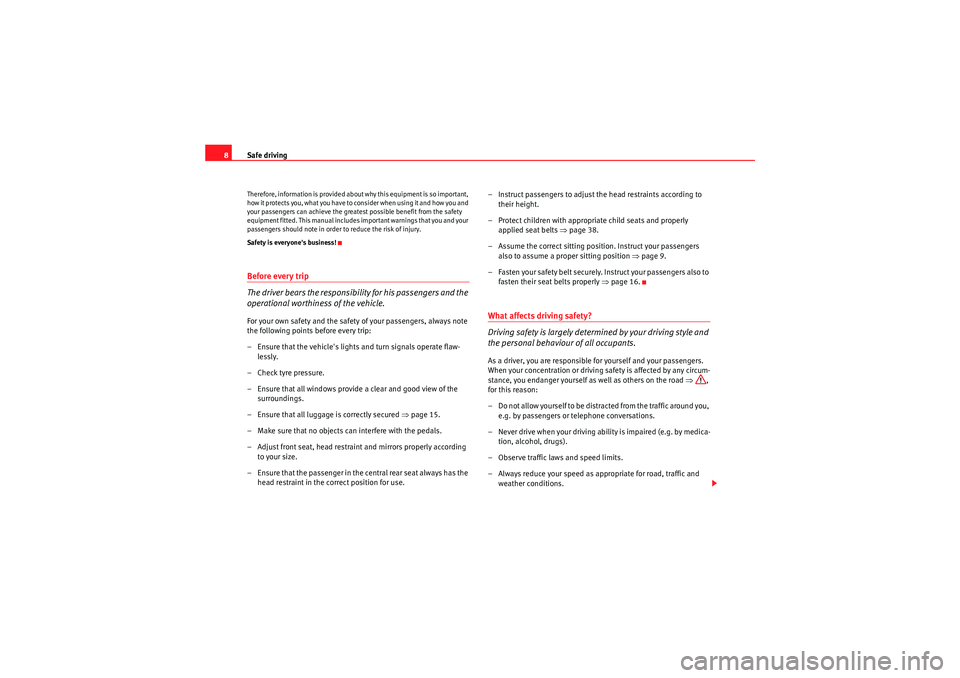
Safe driving
8Therefore, information is provided about why this equipment is so important,
h o w i t p r o t e c t s yo u , w h a t yo u ha v e to co n s i d e r w h e n u s i n g i t a n d h o w yo u a n d
your passengers can achieve the greatest possible benefit from the safety
equipment fitted. This manual includes important warnings that you and your
passengers should note in order to reduce the risk of injury.
Safety is everyone's business!Before every trip
The driver bears the responsibility for his passengers and the
operational worthiness of the vehicle.For your own safety and the safety of your passengers, always note
the following points before every trip:
– Ensure that the vehicle's lights and turn signals operate flaw-
lessly.
– Check tyre pressure.
– Ensure that all windows provide a clear and good view of the surroundings.
– Ensure that all luggage is correctly secured ⇒page 15.
– Make sure that no objects can interfere with the pedals.
– Adjust front seat, head restraint and mirrors properly according to your size.
– Ensure that the passenger in the central rear seat always has the head restraint in the co rrect position for use. – Instruct passengers to adjust the head restraints according to
their height.
– Protect children with appropriate child seats and properly applied seat belts ⇒page 38.
– Assume the correct sitting position. Instruct your passengers also to assume a proper sitting position ⇒page 9.
– Fasten your safety belt securely. Instruct your passengers also to fasten their seat belts properly ⇒ page 16.
What affects driving safety?
Driving safety is largely determined by your driving style and
the personal behaviour of all occupants.As a driver, you are responsible for yourself and your passengers.
When your concentration or driving safety is affected by any circum-
stance, you endanger yourself as well as others on the road ⇒,
for this reason:
– Do not allow yourself to be distracted from the traffic around you, e.g. by passengers or telephone conversations.
– Never drive when your driving abil ity is impaired (e.g. by medica-
tion, alcohol, drugs).
– Observe traffic laws and speed limits.
– Always reduce your speed as appropriate for road, traffic and weather conditions.
IbizaSC_EN.book Seite 8 Mittwoch, 16. September 2009 12:11 12
Page 19 of 257
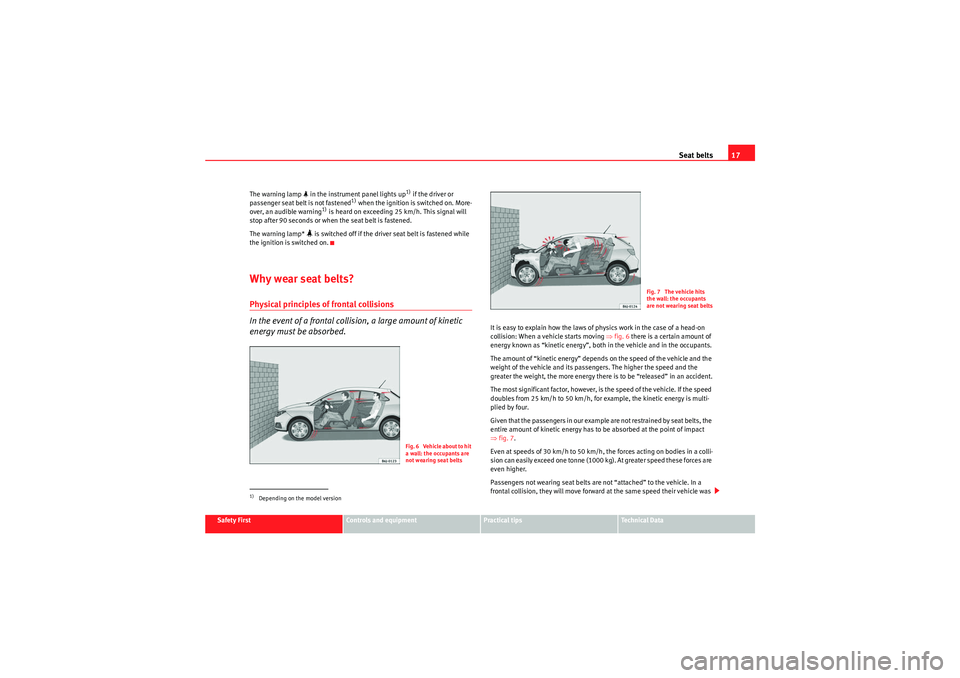
Seat belts17
Safety First
Controls and equipment
Practical tips
Technical Data
The warning lamp
in the instrument panel lights up
1) if the driver or
passenger seat belt is not fastened
1) when the ignition is switched on. More-
over, an audible warning
1) is heard on exceeding 25 km/h. This signal will
stop after 90 seconds or when the seat belt is fastened.
The warning lamp*
is switched off if the driver seat belt is fastened while
the ignition is switched on.
Why wear seat belts?Physical principles of frontal collisions
In the event of a frontal collision, a large amount of kinetic
energy must be absorbed.
It is easy to explain how the laws of physics work in the case of a head-on
collision: When a vehicle starts moving ⇒fig. 6 there is a certain amount of
energy known as “kinetic energy”, both in the vehicle and in the occupants.
The amount of “kinetic energy” depends on the speed of the vehicle and the
weight of the vehicle and its passengers. The higher the speed and the
greater the weight, the more energy there is to be “released” in an accident.
The most significant factor, however, is the speed of the vehicle. If the speed
doubles from 25 km/h to 50 km/h, for example, the kinetic energy is multi-
plied by four.
Given that the passengers in our example are not restrained by seat belts, the
entire amount of kinetic energy has to be absorbed at the point of impact
⇒ fig. 7 .
Even at speeds of 30 km/h to 50 km/h, the forces acting on bodies in a colli-
sion can easily exceed one tonne (1000 kg). At greater speed these forces are
even higher.
Passengers not wearing seat belts are not “attached” to the vehicle. In a
frontal collision, they will move forward at the same speed their vehicle was
1)Depending on the model version
Fig. 6 Vehicle about to hit
a wall: the occupants are
not wearing seat belts
Fig. 7 The vehicle hits
the wall: the occupants
are not wearing seat belts
IbizaSC_EN.book Seite 17 Mittwoch, 16. September 2009 12:11 12
Page 29 of 257
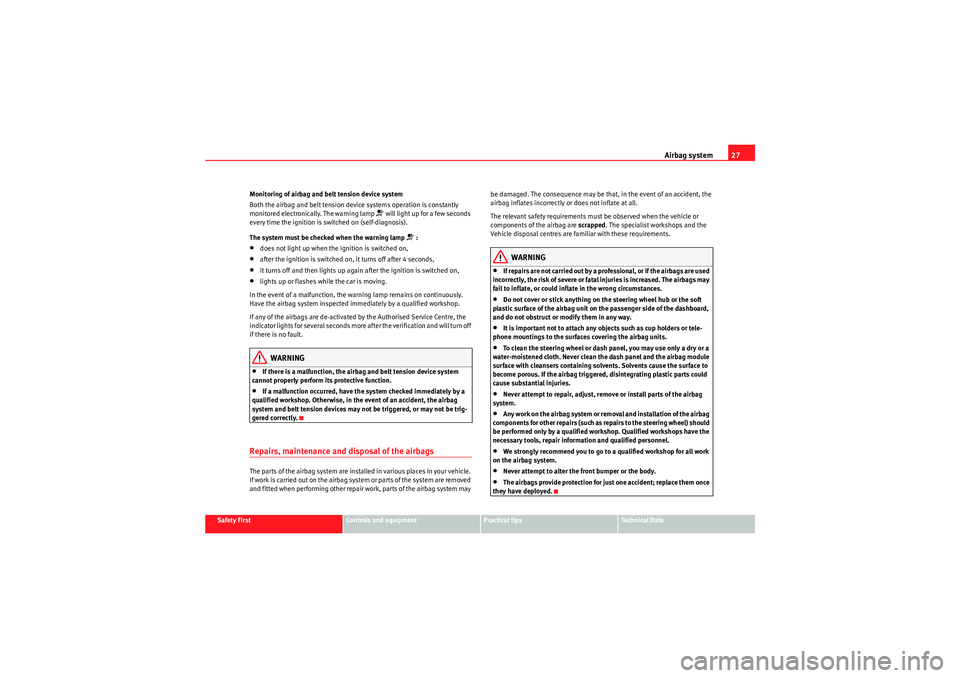
Airbag system27
Safety First
Controls and equipment
Practical tips
Technical Data
Monitoring of airbag and belt tension device system
Both the airbag and belt tension device systems operation is constantly
monitored electronically. The warning lamp
will light up for a few seconds
every time the ignition is switched on (self-diagnosis).
The system must be checked when the warning lamp
:
•does not light up when the ignition is switched on,•after the ignition is switched on, it turns off after 4 seconds,•it turns off and then lights up again after the ignition is switched on,•lights up or flashes while the car is moving.
In the event of a malfunction, the warning lamp remains on continuously.
Have the airbag system inspected immediately by a qualified workshop.
If any of the airbags are de-activated by the Authorised Service Centre, the
indicator lights for several seconds more after the verification and will turn off
if there is no fault.WARNING
•If there is a malfunction, the airbag and belt tension device system
cannot properly perform its protective function.•If a malfunction occurred, have the system checked immediately by a
qualified workshop. Otherwise, in the event of an accident, the airbag
system and belt tension devices may not be triggered, or may not be trig-
gered correctly.
Repairs, maintenance and disposal of the airbagsThe parts of the airbag system are instal led in various places in your vehicle.
If work is carried out on the airbag system or parts of the system are removed
and fitted when performing other repair work, parts of the airbag system may be damaged. The consequence may be that, in the event of an accident, the
airbag inflates incorrectly or does not inflate at all.
The relevant safety requirements must be observed when the vehicle or
components of the airbag are
scrapped. The specialist workshops and the
Vehicle disposal centres are familiar with these requirements.
WARNING
•If repairs are not carried out by a professional, or if the airbags are used
incorrect ly, th e ris k of se vere or fatal inj uries is increas ed. T he airbags may
fail to inflate, or could inflate in the wrong circumstances.•Do not cover or stick anything on the steering wheel hub or the soft
plastic surface of the airbag unit on the passenger side of the dashboard,
and do not obstruct or modify them in any way.•It is important not to attach any objects such as cup holders or tele-
phone mountings to the surfaces covering the airbag units.•To clean the steering wheel or dash panel, you may use only a dry or a
water-moistened cloth. Never clean the dash panel and the airbag module
surface with cleansers containing solvents. Solvents cause the surface to
become porous. If the airbag triggered, disintegrating plastic parts could
cause substantial injuries.•Never attempt to repair, adjust, remove or install parts of the airbag
system.•Any work on the airbag system or removal and installation of the airbag
components for other repairs (such as repairs to the steering wheel) should
be performed only by a qualified workshop. Qualified workshops have the
necessary tools, repair information and qualified personnel.•We strongly recommend you to go to a qualified workshop for all work
on the airbag system.•Never attempt to alter the front bumper or the body.•The airbags provide protection for just one accident; replace them once
they have deployed.
IbizaSC_EN.book Seite 27 Mittwoch, 16. September 2009 12:11 12
Page 30 of 257
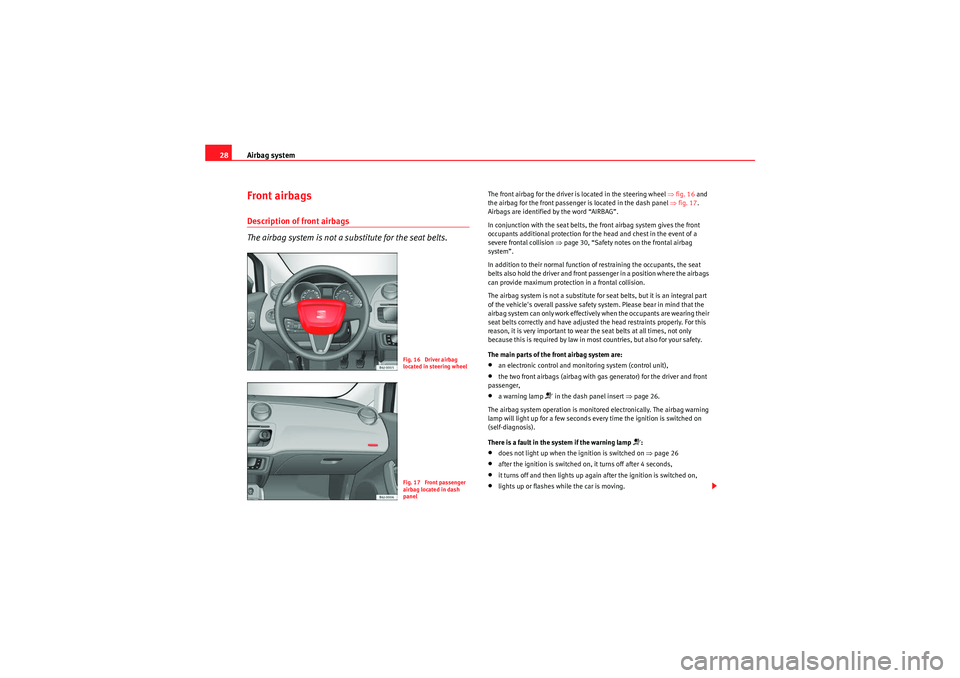
Airbag system
28Front airbagsDescription of front airbags
The airbag system is not a substitute for the seat belts.
The front airbag for the driver is located in the steering wheel ⇒fig. 16 and
the airbag for the front passenger is located in the dash panel ⇒fig. 17.
Airbags are identified by the word “AIRBAG”.
In conjunction with the seat belts, the front airbag system gives the front
occupants additional protection for the head and chest in the event of a
severe frontal collision ⇒ page 30, “Safety notes on the frontal airbag
system”.
In addition to their normal function of restraining the occupants, the seat
belts also hold the driver and front passenger in a position where the airbags
can provide maximum protection in a frontal collision.
The airbag system is not a substitute for seat belts, but it is an integral part
of the vehicle's overall passive safety system. Please bear in mind that the
airbag system can only work effectively when the occupants are wearing their
seat belts correctly and have adjusted the head restraints properly. For this
reason, it is very important to wear the seat belts at all times, not only
because this is required by law in most countries, but also for your safety.
The main parts of the front airbag system are:•an electronic control and monitoring system (control unit),•the two front airbags (airbag with gas generator) for the driver and front
passenger,•a warning lamp
in the dash panel insert ⇒page 26.
The airbag system operation is monitored electronically. The airbag warning
lamp will light up for a few seconds every time the ignition is switched on
(self-diagnosis).
There is a fault in the system if the warning lamp
:
•does not light up when the ignition is switched on ⇒ page 26•after the ignition is switched on, it turns off after 4 seconds,•it turns off and then lights up again after the ignition is switched on,•lights up or flashes while the car is moving.
Fig. 16 Driver airbag
located in steering wheelFig. 17 Front passenger
airbag located in dash
panel
IbizaSC_EN.book Seite 28 Mittwoch, 16. September 2009 12:11 12
Page 49 of 257
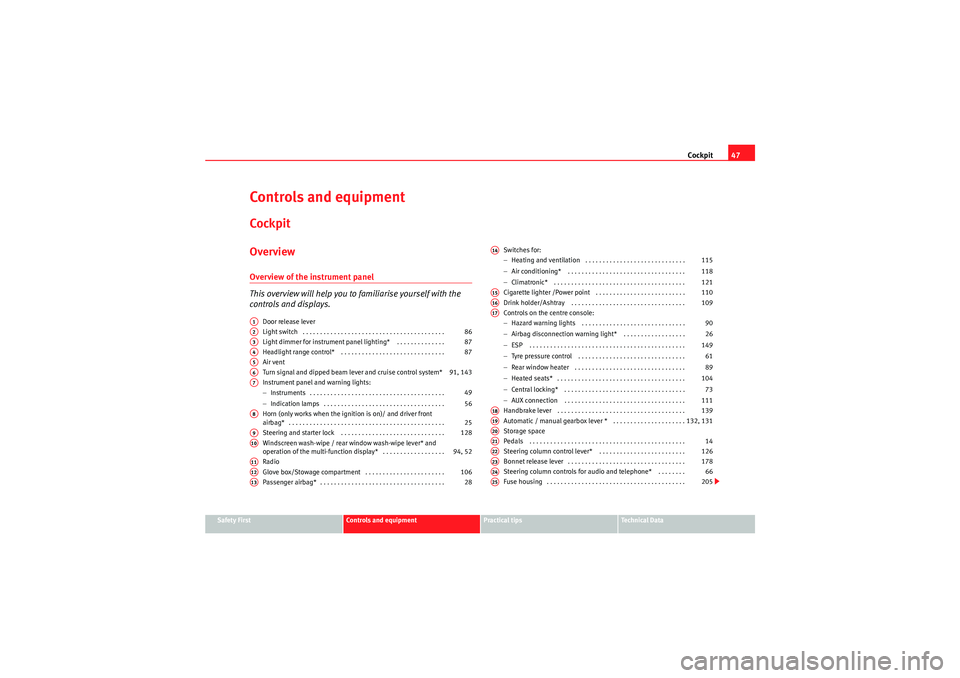
Cockpit47
Safety First
Controls and equipment
Practical tips
Technical Data
Controls and equipmentCockpitOverviewOverview of the instrument panel
This overview will help you to familiarise yourself with the
controls and displays.
Door release lever
Light switch . . . . . . . . . . . . . . . . . . . . . . . . . . . . . . . . . . . . . . . . .
Light dimmer for instrument panel lighting* . . . . . . . . . . . . . .
Headlight range control* . . . . . . . . . . . . . . . . . . . . . . . . . . . . . .
Air vent
Turn signal and dipped beam lever and cruise control system*
Instrument panel and warning lights:
− Instruments . . . . . . . . . . . . . . . . . . . . . . . . . . . . . . . . . . . . . . .
− Indication lamps . . . . . . . . . . . . . . . . . . . . . . . . . . . . . . . . . . .
Horn (only works when the ignition is on)/ and driver front
airbag* . . . . . . . . . . . . . . . . . . . . . . . . . . . . . . . . . . . . . . . . . . . . .
Steering and starter lock . . . . . . . . . . . . . . . . . . . . . . . . . . . . . .
Windscreen wash-wipe / rear window wash-wipe lever* and
operation of the multi-function display* . . . . . . . . . . . . . . . . . .
Radio
Glove box/Stowage compartment . . . . . . . . . . . . . . . . . . . . . . .
Passenger airbag* . . . . . . . . . . . . . . . . . . . . . . . . . . . . . . . . . . . . Switches for:
−
Heating and ventilation . . . . . . . . . . . . . . . . . . . . . . . . . . . . .
− Air conditioning* . . . . . . . . . . . . . . . . . . . . . . . . . . . . . . . . . .
− Climatronic* . . . . . . . . . . . . . . . . . . . . . . . . . . . . . . . . . . . . . .
Cigarette lighter /Power point . . . . . . . . . . . . . . . . . . . . . . . . . .
Drink holder/Ashtray . . . . . . . . . . . . . . . . . . . . . . . . . . . . . . . . .
Controls on the centre console:
− Hazard warning lights . . . . . . . . . . . . . . . . . . . . . . . . . . . . . .
− Airbag disconnection warning light* . . . . . . . . . . . . . . . . . .
− ESP . . . . . . . . . . . . . . . . . . . . . . . . . . . . . . . . . . . . . . . . . . . . .
− Tyre pressure control . . . . . . . . . . . . . . . . . . . . . . . . . . . . . . .
− Rear window heater . . . . . . . . . . . . . . . . . . . . . . . . . . . . . . . .
− Heated seats* . . . . . . . . . . . . . . . . . . . . . . . . . . . . . . . . . . . . .
− Central locking* . . . . . . . . . . . . . . . . . . . . . . . . . . . . . . . . . . .
− AUX connection . . . . . . . . . . . . . . . . . . . . . . . . . . . . . . . . . . .
Handbrake lever . . . . . . . . . . . . . . . . . . . . . . . . . . . . . . . . . . . . .
Automatic / manual gearbox lever * . . . . . . . . . . . . . . . . . . . . .
Storage space
Pedals . . . . . . . . . . . . . . . . . . . . . . . . . . . . . . . . . . . . . . . . . . . . .
Steering column control lever* . . . . . . . . . . . . . . . . . . . . . . . . .
Bonnet release lever . . . . . . . . . . . . . . . . . . . . . . . . . . . . . . . . . .
Steering column controls for audio and telephone* . . . . . . . .
Fuse housing . . . . . . . . . . . . . . . . . . . . . . . . . . . . . . . . . . . . . . . .
A1A2
86
A3
87
A4
87
A5A6
91, 143
A7
49
56
A8
25
A9
128
A10
94, 52
A11A12
106
A13
28
A14
115
118
121
A15
110
A16
109
A17
90
26
149 61
89
104 73
111
A18
139
A19
132, 131
A20A21
14
A22
126
A23
178
A24
66
A25
205
IbizaSC_EN.book Seite 47 Mittwoch, 16. September 2009 12:11 12
Page 60 of 257
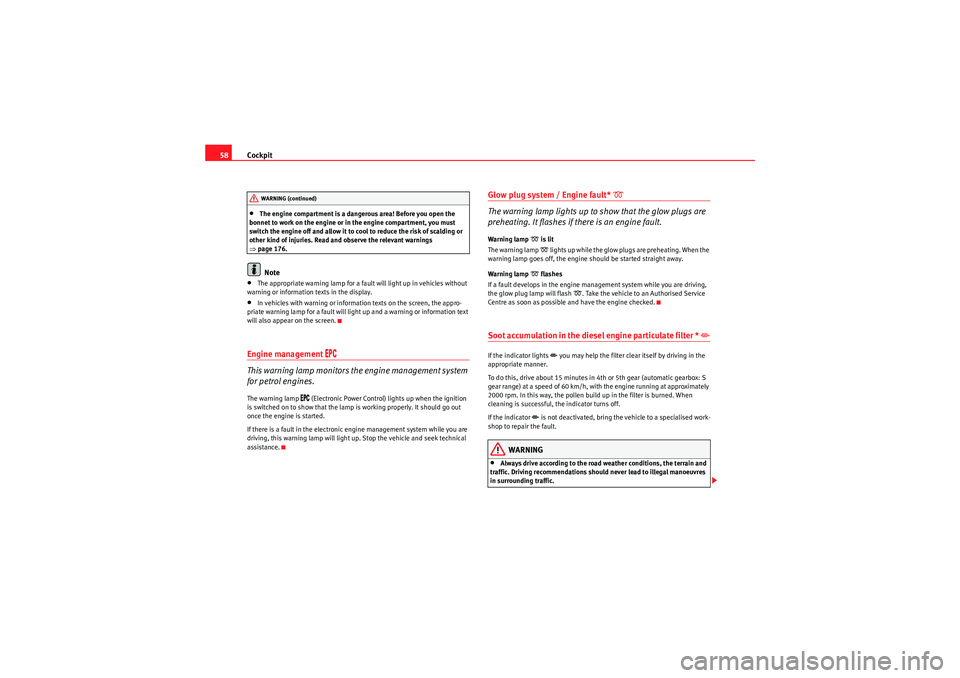
Cockpit
58•The engine compartment is a dangerous area! Before you open the
bonnet to work on the engine or in the engine compartment, you must
switch the engine off and allow it to cool to reduce the risk of scalding or
other kind of injuries. Read and observe the relevant warnings
⇒ page 176.Note
•The appropriate warning lamp for a fault will light up in vehicles without
warning or information texts in the display.•In vehicles with warning or information texts on the screen, the appro-
priate warning lamp for a fault will light up and a warning or information text
will also appear on the screen.Engine management
This warning lamp monitors the engine management system
for petrol engines.
The warning lamp
(Electronic Power Control) lights up when the ignition
is switched on to show that the lamp is working properly. It should go out
once the engine is started.
If there is a fault in the electronic engine management system while you are
driving, this warning lamp will light up. Stop the vehicle and seek technical
assistance.
Glow plug system / Engine fault*
The warning lamp lights up to show that the glow plugs are
preheating. It flashes if there is an engine fault.
Warning lamp
is lit
The warning lamp lights up while the glow plugs are preheating. When the
warning lamp goes off, the engine should be started straight away.
Warning lamp
flashes
If a fault develops in the engine management system while you are driving,
the glow plug lamp will flash
. Take the vehicle to an Authorised Service
Centre as soon as possible and have the engine checked.
Soot accumulation in the diesel engine particulate filter *
If the indicator lights
you may help the filter clear itself by driving in the
appropriate manner.
To do this, drive about 15 minutes in 4th or 5th gear (automatic gearbox: S
gear range) at a speed of 60 km/h, with the engine running at approximately
2000 rpm. In this way, the pollen build up in the filter is burned. When
cleaning is successful, the indicator turns off.
If the indicator
is not deactivated, bring the vehicle to a specialised work-
shop to repair the fault.
WARNING
•Always drive according to the road weather conditions, the terrain and
traffic. Driving recommendations should never lead to illegal manoeuvres
in surrounding traffic.
WARNING (continued)
IbizaSC_EN.book Seite 58 Mittwoch, 16. September 2009 12:11 12
Page 61 of 257
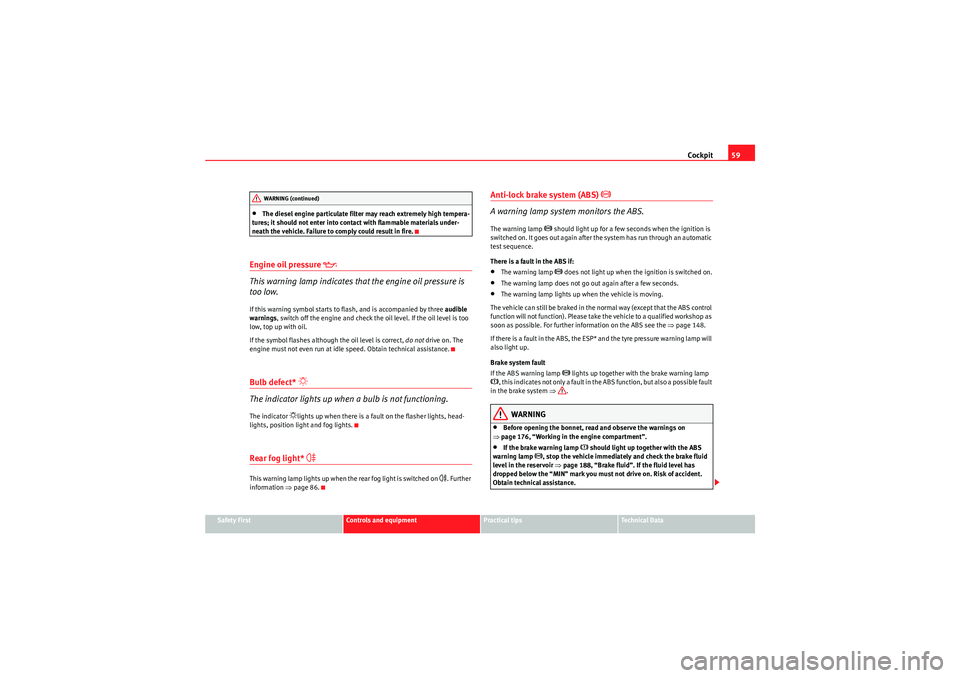
Cockpit59
Safety First
Controls and equipment
Practical tips
Technical Data
•The diesel engine particulate filter may reach extremely high tempera-
tures; it should not enter into contact with flammable materials under-
neath the vehicle. Failure to comply could result in fire.
Engine oil pressure
This warning lamp indicates that the engine oil pressure is
too low.If this warning symbol starts to flash, and is accompanied by three audible
warnings , switch off the engine and check the oil level. If the oil level is too
low, top up with oil.
If the symbol flashes although the oil level is correct, do not drive on. The
engine must not even run at idle speed. Obtain technical assistance.Bulb defect*
The indicator lights up when a bulb is not functioning.The indicator
lights up when there is a fault on the flasher lights, head-
lights, position light and fog lights.
Rear fog light*
This warning lam p lights up when the rear fog light is switched on
. Further
information ⇒page 86.
Anti-lock brake system (ABS)
A warning lamp system monitors the ABS.
The warning lamp
should light up for a few seconds when the ignition is
switched on. It goes out again after the system has run through an automatic
test sequence.
There is a fault in the ABS if:
•The warning lamp
does not light up when the ignition is switched on.
•The warning lamp does not go out again after a few seconds.•The warning lamp lights up when the vehicle is moving.
The vehicle can still be braked in the normal way (except that the ABS control
function will not function). Please take the vehicle to a qualified workshop as
soon as possible. For further information on the ABS see the ⇒page 148.
If there is a fault in the ABS, the ESP* and the tyre pressure warning lamp will
also light up.
Brake system fault
If the ABS warning lamp
lights up together with the brake warning lamp
, this indicates not only a fault in the ABS function, but also a possible fault
in the brake system ⇒.
WARNING
•Before opening the bonnet, read and observe the warnings on
⇒ page 176, “Working in the engine compartment”.•If the brake warning lamp
should light up together with the ABS
warning lamp
, stop the vehicle immediately and check the brake fluid
level in the reservoir ⇒ page 188, “Brake fluid”. If the fluid level has
dropped below the “MIN” mark you must not drive on. Risk of accident.
Obtain technical assistance.
WARNING (continued)
IbizaSC_EN.book Seite 59 Mittwoch, 16. September 2009 12:11 12
Page 62 of 257
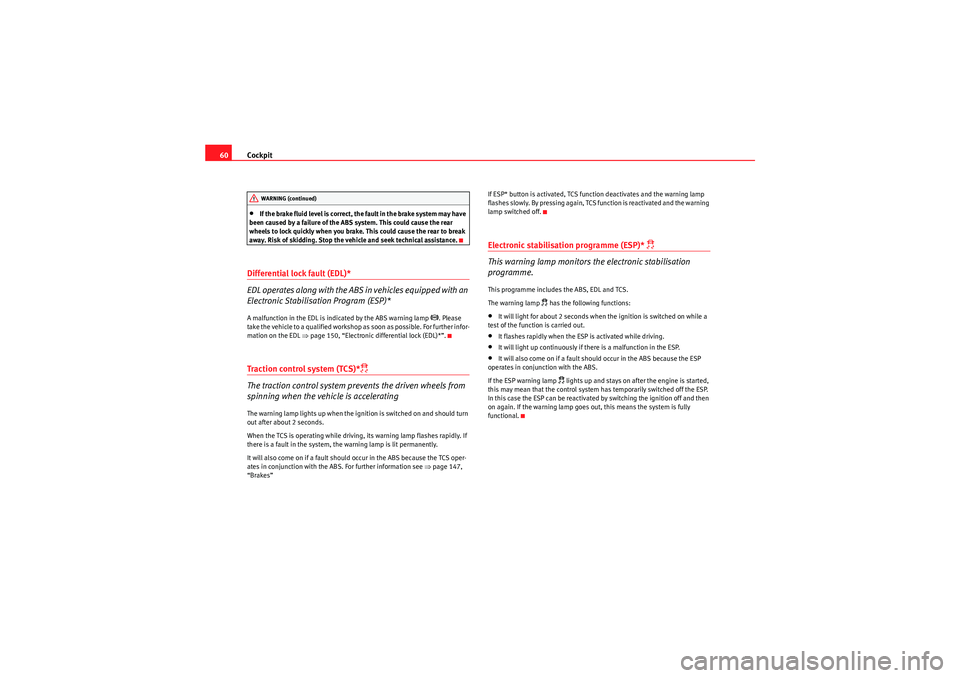
Cockpit
60•If the brake fluid level is correct, the fault in the brake system may have
been caused by a failure of the ABS system. This could cause the rear
wheels to lock quickly when you brake. This could cause the rear to break
away. Risk of skidding. Stop the vehicle and seek technical assistance.
Differential lock fault (EDL)*
EDL operates along with the ABS in vehicles equipped with an
Electronic Stabilisation Program (ESP)*A malfunction in the EDL is indicated by the ABS warning lamp
. Please
take the vehicle to a qualified workshop as soon as possible. For further infor-
mation on the EDL ⇒page 150, “Electronic differential lock (EDL)*”.
Traction control system (TCS)*
The traction control system prevents the driven wheels from
spinning when the vehicle is acceleratingThe warning lamp lights up when the ignition is switched on and should turn
out after about 2 seconds.
When the TCS is operating while driving, its warning lamp flashes rapidly. If
there is a fault in the system, the warning lamp is lit permanently.
It will also come on if a fault should occur in the ABS because the TCS oper-
ates in conjunction with the ABS. For further information see ⇒page 147,
“Brakes” If ESP* button is activated, TCS function deactivates and the warning lamp
flashes slowly. By pressing again, TCS function is reactivated and the warning
lamp switched off.
Electronic stabilisation programme (ESP)*
This warning lamp monitors the electronic stabilisation
programme.
This programme includes the ABS, EDL and TCS.
The warning lamp
has the following functions:
•It will light for about 2 seconds when the ignition is switched on while a
test of the function is carried out.•It flashes rapidly when the ESP is activated while driving.•It will light up continuously if there is a malfunction in the ESP.•It will also come on if a fault should occur in the ABS because the ESP
operates in conjunction with the ABS.
If the ESP warning lamp
lights up and stays on after the engine is started,
this may mean that the control system has temporarily switched off the ESP.
In this case the ESP can be reactivated by switching the ignition off and then
on again. If the warning lamp goes out, this means the system is fully
functional.
WARNING (continued)
IbizaSC_EN.book Seite 60 Mittwoch, 16. September 2009 12:11 12
Page 63 of 257
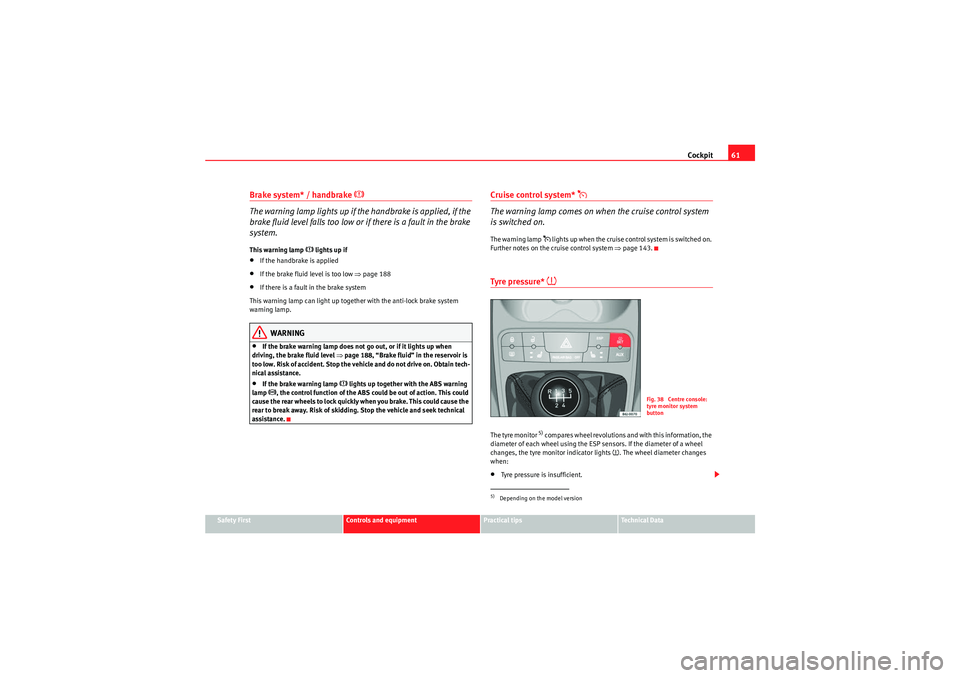
Cockpit61
Safety First
Controls and equipment
Practical tips
Technical Data
Brake system* / handbrake
The warning lamp lights up if the handbrake is applied, if the
brake fluid level falls too low or if there is a fault in the brake
system.
This warning lamp
lights up if
•If the handbrake is applied•If the brake fluid level is too low ⇒page 188•If there is a fault in the brake system
This warning lamp can light up together with the anti-lock brake system
warning lamp.WARNING
•If the brake warning lamp does not go out, or if it lights up when
driving, the brake fluid level ⇒page 188, “Brake fluid” in the reservoir is
too low. Risk of accident. Stop the vehicle and do not drive on. Obtain tech-
nical assistance.•If the brake warning lamp
lights up together with the ABS warning
lamp
, the control function of the ABS could be out of action. This could
cause the rear wheels to lock quickly when you brake. This could cause the
rear to break away. Risk of skidding. Stop the vehicle and seek technical
assistance.
Cruise control system*
The warning lamp comes on when the cruise control system
is switched on.The warning lamp
lights up when the cruise control system is switched on.
Further notes on the cruise control system ⇒page 143.
Tyre pressure*
The tyre monitor
5) co m p a r e s w h e e l r e v o l u t i o ns a n d wi t h t h is i n f o r m a t i o n , t h e
diameter of each wheel using the ESP sensors. If the diameter of a wheel
changes, the tyre monitor indicator lights . The wheel diameter changes
when:
•Tyre pressure is insufficient.5)Depending on the model version
Fig. 38 Centre console:
tyre monitor system
button
IbizaSC_EN.book Seite 61 Mittwoch, 16. September 2009 12:11 12